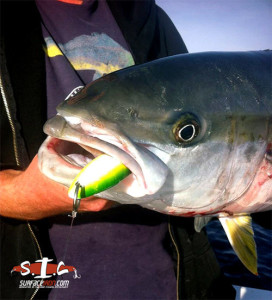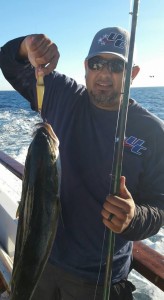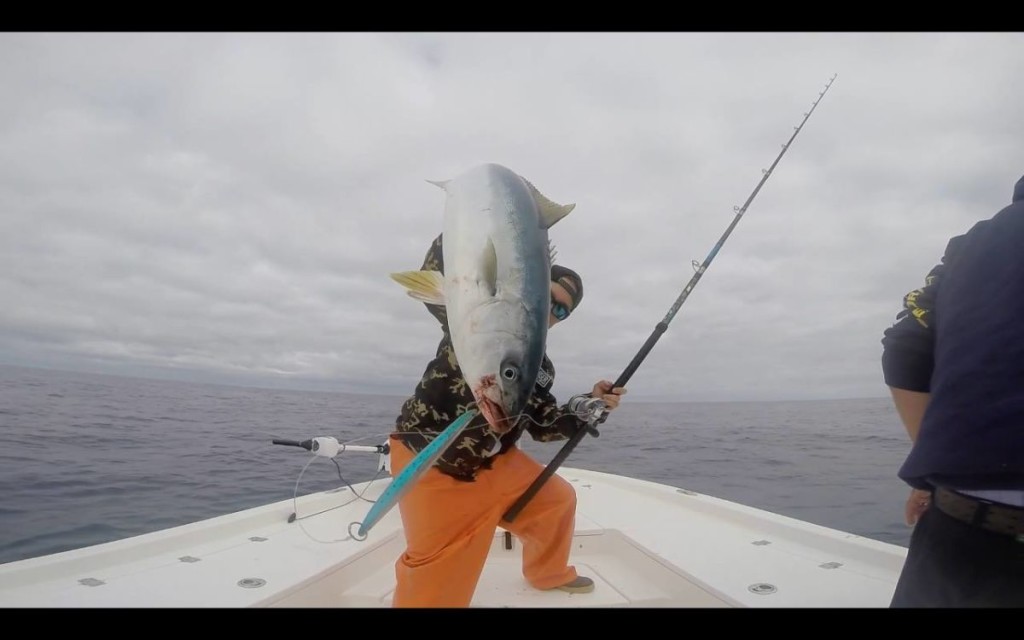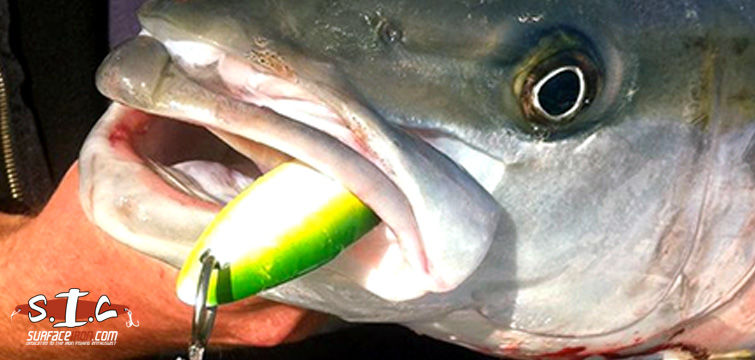Tips on how to fish SoCal’s sacred Surface Iron.
 It’s All in the DetailsUnless you fish in Southern California, odds are you probably don’t use a surface iron. However, for the past 60 years these classic SoCal lures have flown off the shelf at local tackle shops.
It’s All in the DetailsUnless you fish in Southern California, odds are you probably don’t use a surface iron. However, for the past 60 years these classic SoCal lures have flown off the shelf at local tackle shops.
The allure of the surface iron is simple… they catch fish.
Surface irons fit into the West Coast style of fishing long rods with smooth-casting conventional reels. Combine the load-ups of an 8- to 10-foot rod and the thumb-off-the- spool release of a classic Newell, Penn or Shimano and you’ve got a quintessential SoCal style of fishing.
Surface-iron fishing blends elements of fly fishing into it, including the importance of “matching the hatch,” picking the right offering, lining up the cast and presenting it just right while keeping current and wind in mind. Anglers must crank the jig back to the boat at the perfect clip depending on choice of lure and conditions at hand.
Like custom marlin lures, surface irons from reputable companies such as Tady and Salas are constructed the same way they were in the 1950s — with human hands. Tady Shimizu and Marty Salas set the standard, grinding down the aluminum jigs one by one. Most other companies that tried to get by with die-casting ended up dying on the vine.
Surface irons come in many sizes, shapes and colors from a variety of manufactures, namely Tady Lures and Salas Jigs. For the Tady set, the Tady 45 is the king of the surface iron, while for those who throw Salas jigs, the 7X is the one most go to. Other sizes thrown in the mix include the AA, A1, C and 77 from Tady, and the 7X Jr., Dart Special, OKI and PL68 from Salas.
Surface irons come in a barrage of colors, from the standard blue-and white to the Salas’ “gay soldier” (military green with a pink tip). Most agree that it’s less about color, and more about the lures’ unique swimming action that attracts fish.
Region Specific
 These jigs are popular sellers at California tackle shops from San Diego to Santa Barbara, but for whatever reason, they haven’t quite caught on elsewhere.
These jigs are popular sellers at California tackle shops from San Diego to Santa Barbara, but for whatever reason, they haven’t quite caught on elsewhere.
But then again, a lot of our SoCal fishing standards have been slow to catch on. Take for example the “deckhand” style rod with no reel seat, long-range sport boats and bait receivers. These are just a few of the facets that make Southern California angling unique. They work out here, and that’s just fine with us.
Those of us who have taken surface-iron jigs to other regions of the world typically do well with them. I’ve caught big barracuda in Florida on iron as well as coral trout and a range of jacks off of Taveuni, Fiji, and big wahoo. Wahoo love the surface iron, especially when thrown back after a fish strikes a trolled lure and fished with a slow wind.
It’s sort of a shame that more guys don’t travel with these lures. Surface irons don’t break, bend, melt or have any moving parts that can turn tackle into a smashed-up nightmare. Plus, outside of California and Baja, most fish have never seen a surface iron swim through the water. That alone gives them an edge.
The long, narrow design makes surface iron tooth-proof by default, and they are good for fish after fish, cast after cast, whereas softer baits — from plastic to balsa — meet the same eventual fate
As an added bonus, many think that surface iron jigs swim better when fished on a piece of single-strand wire with a haywire twist used to connect the iron to a swivel.
The Jig Stick

Sit by a sportboat’s bait tank or a tackle shop’s counter long enough and you’ll hear conversations and often
conflicting arguments, about which rod is the best jig stick. Is it made from fiberglass or graphite or a composite of the two? Which rod gets a jig out the furthest? The debates ebb and flow, and we haven’t even brought reels and line into the equation.
When it comes to choosing a rod for fishing surface iron, there are no fewer than 20 specific rods purpose-built by Seeker and Calstar alone. Look at their offerings and the laundry list of blank letters including SS, GF, GG, BT that lead into the classic numbers like 90J, 100J, 530, 540, 690 tell the story of nine and 10-foot rods made from glass and graphite composites.
These days I’d take a Super Seeker Ulua 93H rod with a Shimano Trinidad 20 DC loaded up with 40-pound Berkley Big Game monofilament rigged to a Tady 45 surface iron.
Half my lifetime ago, it would have been a Calstar 540 rod paired with a Newell 332 reel. And then you have the classics. To this day a Harnell 724 jig stick matched with any reel that can throw a jig is always near the top of my list.
Where to Fish the Iron
Anglers can cast surface irons up and over reef ledges, throw one over a flat or toss an iron into a melee of breaking fish.
Fishing a surface iron is a lesson in simplicity. Make long casts and wind at a medium to medium-fast retrieve after letting the surface iron sink out for three to 10 seconds. This is the crux of fishing the surface iron, at least when coupled with the paramount rule — never set the hook — just keep turning the handle until line starts coming off the reel or the fish is in the boat.

